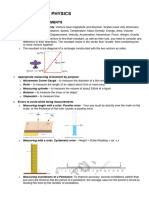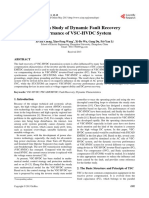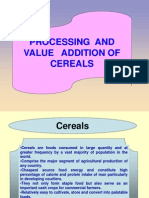Edexcel M1 Summary Notes
Uploaded by
AlexanderBrazdaLorenteEdexcel M1 Summary Notes
Uploaded by
AlexanderBrazdaLorenteEdexcel GCE Mechanics (M1)
Required Knowledge Information Sheet
Daniel Hammocks
Common Modelling Assumptions
Particle
- An object which is small in comparison with other sizes or lengths can be
modelled as a particle. This means that the mass of the object can be
considered to be concentrated at a single point (a particle is often referred to
as a point-mass). The fact that a particle has no dimensions means that we
can ignore the rotational effect of any forces that are acting on it as well as
any effects due to air resistance.
Rod
- An object with one dimension small in comparison with another (such as a
metre ruler or beam) can be modelled as a rod. This means that the mass of
the object can be considered to be distributed along a straight line. A rod has
no thickness (it is one-dimensional) and is rigid (it does not bend or buckle).
Lamina
- An object with one dimension (its thickness) very small in comparison with
the other two (its length and width) can be modelled as a lamina. This means
that the mass of the object can be considered to be distributed across a flat
surface. A lamina has no thickness (it is two-dimensional). For example, a
sheet of paper or metal could be modelled as a lamina.
Uniform Body - If an object is uniform then its mass is evenly distributed over its entire
volume. This means that the mass of the body can be considered to be
concentrated at a single point (known as the centre of mass), at the
geometrical centre of the body. For example, an unsharpened pencil could
be modelled as a uniform rod. However, once it is sharpened then its centre
of mass would not be at its mid-point and we would model it as a nonuniform rod.
Light Object
- If the mass of an object is very small in comparison with the masses of other
objects, we can model it as being light. This means that we can ignore its
mass altogether and treat it as having zero mass. Strings and pulleys are
often modelled as being light.
Inextensible
- If a string does not stretch under a load it is inextensible or inelastic.
Smooth
- If we want to ignore the effects of friction, we can model a surface as being
smooth. This means that we assume there is no friction between the surface
and any object which is moving or tending to move along it.
Rough Surface - If a surface is not smooth it is said to be rough. We need to consider the
friction between the surface and an object moving or tending to move along
it. For example, a ski slope might be modelled as a smooth or a rough surface
depending on the problem to be solved.
Daniel Hammocks
Wire
- A rigid thin length of metal, which is treated as being one-dimensional, is
referred to as a wire. A wire can be smooth or rough. We often consider
beads which are threaded on a wire.
Bead
- A particle which can be threaded onto, and move freely along, a wire or
string is called a bead.
Peg
- A support from which an object can be suspended or on which an object can
rest is called a peg. A peg is treated as being dimensionless (it is treated as a
point) as is usually fixed. A peg can be rough or smooth.
Air Resistance - When an object moves through the air it experiences a resistance due to
friction.
Wind
- Unless it is specifically mentioned, you can usually ignore any effects due to
the wind in your models.
Gravity
- The force of attraction between all objects with mass
is called gravity. Because the mass of the earth is very
large, we can usually assume that all objects are
attracted towards the Earth (ignoring any force of
attraction between the objects themselves). We usually
model the force of the Earths gravity as uniform, and
acting vertically downwards. The acceleration due to
gravity is denoted by g and is always assumed to be
constant at 9.8ms-2. This value is given on the front of
the exam paper.
Daniel Hammocks
Kinematics of a Particle Moving in a Straight Line
You need to know what these symbols represent
S
Displacement (distance)
U
Starting (Initial) Velocity
V
Final Velocity
A
Acceleration
T
Time
If a particle is slowing down it has a negative acceleration. This is called deceleration
or retardation.
All measurements need to be converted into base SI units before substituting their
values into the formulae
Measurement
Time (t)
Displacement (s)
Velocity (v or u)
Acceleration (a)
SI Unit
Seconds (s)
Metres (m)
Metres per Second (ms-1)
Metres per Second per Second (ms-2)
The five formulae for solving problems about particles moving in a straight line with
constant acceleration are
o v = u + at
o s = (u + v)t
o v2 = u2 + 2as
o s = ut +at2
o s = vt - at2
An object moving vertically in a straight line can be modelled as a particle with a
constant downward acceleration of g = 9.8ms-2
The gradient of a speed-time graph illustrating the motion of a particle represents
the acceleration of the particle
The area under a speed-time graph illustrating the motion of a particle represents
the distance moved by the particle
Area of trapezium
= average of the parallel sides x height
= (a + b) x h
At constant speed, distance = speed x time
Daniel Hammocks
Dynamics of a Particle Moving in a Straight Line
The unit of force is the Newton (N). It is defined as the force that will cause a mass of
1kg to accelerate at a rate of 1ms-2
o F = ma
The force due to gravity is called the weight of an object, and it acts vertically
downwards. A particle falling freely experiences acceleration of g = 9.8ms-2
o W = mg
The component of a force of magnitude F acting in a certain direction is F cosine(),
where is the size of the angle between the force and the direction
The maximum or limiting value of the friction FMAX between two surfaces is given by
o FMAX = R
where is the coefficient of friction and R is the normal reaction between the two
surfaces
If a force P is applied to a block of mass m which is at rest on a rough horizontal
surface and P acts at an angle to the horizontal:
o The normal reaction R is not equal to mg
o The force tending to pull or push the block along the plane is not equal to P
A particle placed on a rough inclined plane will remain at rest if tangent() where
is the angle the plane makes with the horizontal and is the coefficient of friction
between the particle and the plane
Provided all parts of a connected system are moving in the same straight line you
can treat the whole system as a single particle
In problems involving particles which are connected by string(s) which pass over
pulley(s) you cannot treat the whole system as a single particle. This is because the
particles are moving in different directions.
The momentum of a body of mass m which is moving with velocity v is mv
o Momentum = mass x velocity
If a constant force F acts for time t then we define the impulse of the force to be Ft
o Impulse = Force x Time
The Impulse-Momentum Principle states that
o Impulse = Final Momentum Initial Momentum = Change in Momentum
o I = mv mu
The principle of Conservation of Momentum states that
o Total Momentum Before Impact = Total Momentum After Impact
o m1u1 + m2u2 = m1v1 + m2v2
Daniel Hammocks
Statics of a Particle
A particle is said to be in equilibrium when it is acted upon by two or more forces
and motion does not take place. This means that the resultant of the forces is zero
and the particle will remain at rest or stationary, as it is not subject to acceleration.
To solve problems in statics you should
o Draw a diagram showing clearly the force acting on the particle(s)
o Resolve the forces into horizontal and vertical components or, if the particle
is on an inclined plane, into components parallel and perpendicular to the
plane
o Set the sum of the components in each direction equal to zero
o Solve the resulting equations to find the unknown force(s) and angle(s)
You can add forces of weight, tension, thrust, normal reaction and friction to a force
diagram as appropriate
The maximum value of the frictional force FMAX = R is reached when the body you
are considering is on the point of moving. The body is then said to be in limiting
equilibrium.
In general the force of friction F is such that F R, where R is the normal reaction.
The direction of the friction force is opposite to the direction in which the body
would move if the friction force were absent.
Moments
A force applied to a rigid body can cause the body to rotate
The moment of a force measures the turning effect of the force on the body on
which it acts.
The moment of the force F about a point P is the product of the magnitude of the
force F and the perpendicular distance from the point P to the line of action of F
o Moment (Nm) = F x d
When you have several coplanar forces acting on a body, you can add the moments
about a point. You need to choose a positive direction (clockwise) and consider the
sense of rotation of each moment.
When the distance given is not the perpendicular distance of the line of action from
the pivot you can find the moment by resolving the force into components.
If a body is resting in equilibrium the resultant force in any direction is zero, and the
sum of the moments at any point is zero.
The mass of a non-uniform rigid body can be modelled as acting at its centre of
mass.
Daniel Hammocks
Vectors
A vector is a quantity which has both magnitude and direction.
A vector can be represented as a directed line segment.
B
AB
Two vectors are equal if and only if they have the same magnitude and the same
direction.
Two vectors are parallel if and only if they have the same direction.
You can add vectors using the triangle of law of addition
R
B
R=A+B
A
The unit vectors along the Cartesian axes are usually denoted by i and j respectively.
You can write any two dimensional vector in the form ai + bj.
When vectors are written in terms of the unit vectors i and j you can add them
together by adding the terms in i and the terms in j separately. You can subtract
vectors in a similar way.
When a vector is given in terms of the unit vectors i and j you can find its magnitude
using Pythagoras Theorem. The magnitude of a vector a is written .
The velocity of a particle is a vector in the direction of motion. The magnitude of the
velocity is the speed of the particle. The velocity is usually denoted by v.
If a particle starts from the point with position vector r0 and moves with constant
velocity v, then its displacement from its initial position at time t is vt and its
position vector r is given by
o r = r0 + vt
The acceleration of a particle tells you how the velocity changes with time.
Acceleration is a vector, usually denoted by a. If a particle with initial velocity u
moves with constant acceleration a then its velocity, v, at time t is given by
o v = u + at
A force applied to a particle has both a magnitude and a direction, so force is also a
vector. The force causes the particle to accelerate
o F = ma, where m is the mass of the particle
If a particle is resting in equilibrium then the resultant of all the forces acting on it is
zero. This means that the sum of the vectors of the forces is the zero vector.
Daniel Hammocks
You might also like
- Mathematics Higher Mock Paper 1 Jan 2024 Version 2 MarkschemeNo ratings yetMathematics Higher Mock Paper 1 Jan 2024 Version 2 Markscheme25 pages
- Physics Practical Skills Workbook AnswersNo ratings yetPhysics Practical Skills Workbook Answers21 pages
- Unit 5 - Physics From Creation To Collapse: Thermal EnergyNo ratings yetUnit 5 - Physics From Creation To Collapse: Thermal Energy12 pages
- Flashcards - 1.1 Mechanics - Edexcel IAL Physics A-LevelNo ratings yetFlashcards - 1.1 Mechanics - Edexcel IAL Physics A-Level75 pages
- International A Level Physics Example Responses PH05 Unit5No ratings yetInternational A Level Physics Example Responses PH05 Unit558 pages
- Answers To Test Yourself Questions: Topic 6No ratings yetAnswers To Test Yourself Questions: Topic 65 pages
- Scalars and Vectors: O Level, Igcse and Gcse Revision NotesNo ratings yetScalars and Vectors: O Level, Igcse and Gcse Revision Notes3 pages
- Kinematics - Questions by Topic: Edexcel (IAL) Physics A-LevelNo ratings yetKinematics - Questions by Topic: Edexcel (IAL) Physics A-Level7 pages
- Stats1 Chapter 2::: Measures of Location & SpreadNo ratings yetStats1 Chapter 2::: Measures of Location & Spread53 pages
- Edexcel GCSE Math Higher Revision Guide - Page 11No ratings yetEdexcel GCSE Math Higher Revision Guide - Page 111 page
- P3 JAN 21 Revision Worksheet All ChaptersNo ratings yetP3 JAN 21 Revision Worksheet All Chapters3 pages
- 9897 - Lesson Note On Linear and Quadratic GraphNo ratings yet9897 - Lesson Note On Linear and Quadratic Graph4 pages
- IGCSE MATHS PAST PAPER 580 - 2004 - QP - 3100% (3)IGCSE MATHS PAST PAPER 580 - 2004 - QP - 316 pages
- Cambridge Learner Guide For As and A Level PhysicsNo ratings yetCambridge Learner Guide For As and A Level Physics4 pages
- Maths November 2016 (v2) QP - Paper 4 CIE Maths IGCSENo ratings yetMaths November 2016 (v2) QP - Paper 4 CIE Maths IGCSE20 pages
- Radians, Trigonometry Revision Notes From A-Level Maths TutorNo ratings yetRadians, Trigonometry Revision Notes From A-Level Maths Tutor4 pages
- SWH Chemistry Edexcel Igcse 9-1 1st Edition 1No ratings yetSWH Chemistry Edexcel Igcse 9-1 1st Edition 132 pages
- physics papers (for 2023 syllabus) - V2No ratings yetphysics papers (for 2023 syllabus) - V242 pages
- Edexcel International A Level Maths Pure Mathematics 1 Wma1101 661043a991815405968c3f73 221No ratings yetEdexcel International A Level Maths Pure Mathematics 1 Wma1101 661043a991815405968c3f73 2218 pages
- Znotes CAIE A2 Level Further Maths Further MechanicsNo ratings yetZnotes CAIE A2 Level Further Maths Further Mechanics15 pages
- Gce A and As Level Physics Topical Past Papers 1976 To 2003 PDF100% (1)Gce A and As Level Physics Topical Past Papers 1976 To 2003 PDF388 pages
- Edexcel IAL MechanicsM1 WME01 Formula SheetNo ratings yetEdexcel IAL MechanicsM1 WME01 Formula Sheet8 pages
- AP Physics B Exam Cram Sheet (Ver. 5.01) General Reminders: X X y y ResultantNo ratings yetAP Physics B Exam Cram Sheet (Ver. 5.01) General Reminders: X X y y Resultant8 pages
- GRADE 6 MELCS For SOCIAL MEDIA TV and RADIO BASED MODALITYNo ratings yetGRADE 6 MELCS For SOCIAL MEDIA TV and RADIO BASED MODALITY11 pages
- Simulation Study of Dynamic Fault Recovery Performance of VSC-HVDC SystemNo ratings yetSimulation Study of Dynamic Fault Recovery Performance of VSC-HVDC System5 pages
- Bagarea in Seama Si Futerea de Mama. Un Studiu Extins de Andu BanduNo ratings yetBagarea in Seama Si Futerea de Mama. Un Studiu Extins de Andu Bandu1 page
- Engingeering Mechanics Dynamics in SI Units 14th Edition Hibbeler Solutions Manualpdf download100% (3)Engingeering Mechanics Dynamics in SI Units 14th Edition Hibbeler Solutions Manualpdf download43 pages
- Heavyweight Concrete: Measuring, Mixing, Transporting, and PlacingNo ratings yetHeavyweight Concrete: Measuring, Mixing, Transporting, and Placing12 pages
- Angle or Repose For Sawdust and Woodchips - Research PaperNo ratings yetAngle or Repose For Sawdust and Woodchips - Research Paper10 pages
- Quiz. The Pleasure Theory The Utilitarians Zge 1103 EthicsNo ratings yetQuiz. The Pleasure Theory The Utilitarians Zge 1103 Ethics17 pages
- Tunnel Fire Protection: A Lost Formwork System, Using PROMATECT - HNo ratings yetTunnel Fire Protection: A Lost Formwork System, Using PROMATECT - H24 pages
- 5 - Foundation Knowledge of Forensic Odontology Lec 1No ratings yet5 - Foundation Knowledge of Forensic Odontology Lec 115 pages
- Mathematics Higher Mock Paper 1 Jan 2024 Version 2 MarkschemeMathematics Higher Mock Paper 1 Jan 2024 Version 2 Markscheme
- Unit 5 - Physics From Creation To Collapse: Thermal EnergyUnit 5 - Physics From Creation To Collapse: Thermal Energy
- Flashcards - 1.1 Mechanics - Edexcel IAL Physics A-LevelFlashcards - 1.1 Mechanics - Edexcel IAL Physics A-Level
- International A Level Physics Example Responses PH05 Unit5International A Level Physics Example Responses PH05 Unit5
- Scalars and Vectors: O Level, Igcse and Gcse Revision NotesScalars and Vectors: O Level, Igcse and Gcse Revision Notes
- Kinematics - Questions by Topic: Edexcel (IAL) Physics A-LevelKinematics - Questions by Topic: Edexcel (IAL) Physics A-Level
- Cambridge Learner Guide For As and A Level PhysicsCambridge Learner Guide For As and A Level Physics
- Maths November 2016 (v2) QP - Paper 4 CIE Maths IGCSEMaths November 2016 (v2) QP - Paper 4 CIE Maths IGCSE
- Radians, Trigonometry Revision Notes From A-Level Maths TutorRadians, Trigonometry Revision Notes From A-Level Maths Tutor
- Edexcel International A Level Maths Pure Mathematics 1 Wma1101 661043a991815405968c3f73 221Edexcel International A Level Maths Pure Mathematics 1 Wma1101 661043a991815405968c3f73 221
- Znotes CAIE A2 Level Further Maths Further MechanicsZnotes CAIE A2 Level Further Maths Further Mechanics
- Gce A and As Level Physics Topical Past Papers 1976 To 2003 PDFGce A and As Level Physics Topical Past Papers 1976 To 2003 PDF
- O level Physics Questions And Answer Practice Papers 3From EverandO level Physics Questions And Answer Practice Papers 3
- AP Physics B Exam Cram Sheet (Ver. 5.01) General Reminders: X X y y ResultantAP Physics B Exam Cram Sheet (Ver. 5.01) General Reminders: X X y y Resultant
- GRADE 6 MELCS For SOCIAL MEDIA TV and RADIO BASED MODALITYGRADE 6 MELCS For SOCIAL MEDIA TV and RADIO BASED MODALITY
- Simulation Study of Dynamic Fault Recovery Performance of VSC-HVDC SystemSimulation Study of Dynamic Fault Recovery Performance of VSC-HVDC System
- Bagarea in Seama Si Futerea de Mama. Un Studiu Extins de Andu BanduBagarea in Seama Si Futerea de Mama. Un Studiu Extins de Andu Bandu
- Engingeering Mechanics Dynamics in SI Units 14th Edition Hibbeler Solutions Manualpdf downloadEngingeering Mechanics Dynamics in SI Units 14th Edition Hibbeler Solutions Manualpdf download
- Heavyweight Concrete: Measuring, Mixing, Transporting, and PlacingHeavyweight Concrete: Measuring, Mixing, Transporting, and Placing
- Angle or Repose For Sawdust and Woodchips - Research PaperAngle or Repose For Sawdust and Woodchips - Research Paper
- Quiz. The Pleasure Theory The Utilitarians Zge 1103 EthicsQuiz. The Pleasure Theory The Utilitarians Zge 1103 Ethics
- Tunnel Fire Protection: A Lost Formwork System, Using PROMATECT - HTunnel Fire Protection: A Lost Formwork System, Using PROMATECT - H
- 5 - Foundation Knowledge of Forensic Odontology Lec 15 - Foundation Knowledge of Forensic Odontology Lec 1

























































































